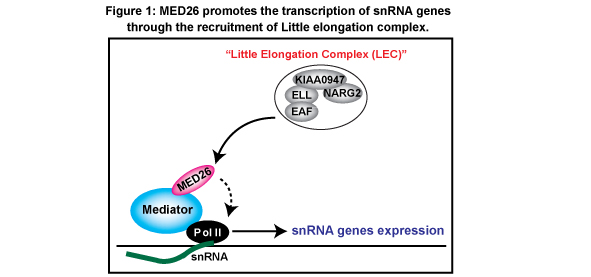Elucidation of the mechanism of small nuclear RNA genes transcription by human Mediator subunit MED26
Research Press Release | January 14, 2015

| Press Release | ||
|---|---|---|
| Key Points |
Small nuclear RNAs (snRNAs) play a crucial role in RNA splicing. In this research, we clarified the mechanism how to regulate the expression of small nuclear RNA genes. We found that human Mediator subunit MED26 regulates the expression of snRNA genes through the recruitment of little elongation complex (LEC). |
|
| Overview |
Regulation of transcription elongation by RNA polymerase II (Pol II) is a key regulatory step in gene transcription. Recently, the LEC—which contains the transcription elongation factor ELL/EAF—was found to be required for the transcription of Pol II-dependent snRNA genes. The snRNA plays an essential role in a maturation process (RNA splicing) of messenger RNA, that is complementary to one of the DNA strands of a gene. Here, we show that the human Mediator subunit MED26 plays a role in the recruitment of LEC to a subset of snRNA genes through direct interaction of LEC and the N-terminal domain (NTD) of MED26. Loss of MED26 in cells decreased the occupancy of LEC at a subset of snRNA genes and results in a reduction in their transcription. Our results also suggested that the MED26 NTD functions as a molecular switch in the exchange of TBP-associated factor 7 (TAF7) for LEC in order to facilitate the transition from initiation to elongation during transcription of a subset of snRNA genes. It has been reported that the expression of many genes is strictly controlled and that the dysregulation of the gene expression often causes cancers or leukemias. Since MED26 also regulates the expression of cancer-related genes, it is possible that MED26 is one of the important molecules to regulate carcinogenesis and leukemogenesis. |
|
| Inquiries |
Hidehisa Takahashi, Assistant Professor, Shigetsugu Hatakeyama, Professor, Department of Biochemistry, Graduate School of Medicine, Hokkaido University TEL: +81-11-706-5047 FAX: +81-11-706-5169 E-mail: hidehisa@med.hokudai.ac.jp E-mail: hatas@med.hokudai.ac.jp |
|
|
Japanese Link |
核内低分子 RNA 遺伝子の発現制御機構の解明 | |
| Publications | MED26 regulates the transcription of snRNA genes through the recruitment of little elongation complex, (Nature Communications, 2015.1.9) | |
